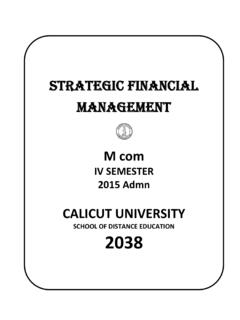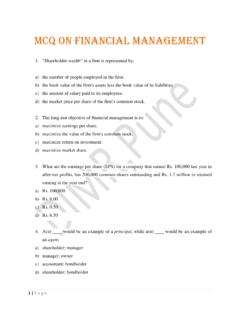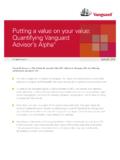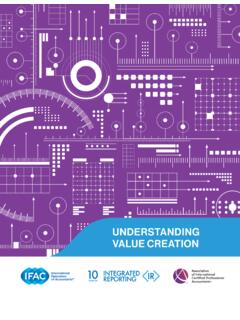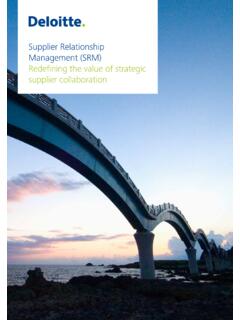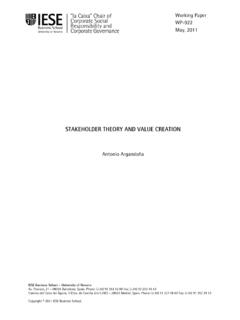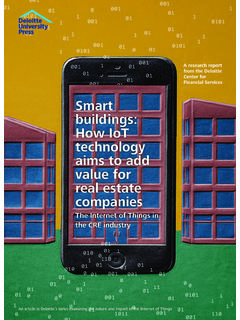Transcription of The Value of Asset Management to an Organization - GFMAM
1 The Value of Asset Management to an Organization First Edition English Version ISBN 0-9870602-6-0 Published August 2016 ISBN 0-9870602-6-0 Page 2 of 11 The Value of Asset Management to an Organization English Version First Edition The Global Forum on Maintenance and Asset Management The Global Forum on Maintenance and Asset Management ( GFMAM ) has been established with the aim of sharing collaboratively advancements, knowledge and standards in Maintenance and Asset Management . The members of GFMAM (at the time of issue of this document) are: Asset Management Council (AMCouncil), Australia Associa o Brasileira de Manuten o e Gest o de Ativos (ABRAMAN), Brazil European Federation of National Maintenance Societies (EFNMS), Europe French Institute of Asset Management and Infrastructures (IFRAMI), France Gulf Society of Maintenance and Reliability (GSMR), Arabian Gulf Region Institute of Asset Management (IAM), UK Japan Institute of Plant Maintenance (JIPM), Japan Plant Engineering and Maintenance Association of Canada (PEMAC), Canada The Society for Maintenance and Reliability Professionals (SMRP), USA The Southern African Asset Management Association (SAAMA), South Africa The enduring objectives of the GFMAM are.
2 1) To bring together, promote and strengthen the maintenance and Asset Management community worldwide 2) To support the establishment and development of associations or institutions whose aims are maintenance and Asset Management focused 3) To facilitate the exchange and alignment of maintenance and Asset Management knowledge and practices 4) To raise the credibility of member organizations by raising the profile of the Global Forum Copyright 2016 by the Global Forum on Maintenance and Asset Management ( GFMAM ) All rights reserved. Anyone may freely use this material unchanged under the condition of acknowledging the original source. ISBN 0-9870602-6-0 Page 3 of 11 The Value of Asset Management to an Organization English Version First Edition Table of Contents 1 Introduction.
3 4 Background .. 4 Acknowledgement .. 4 Purpose .. 4 2 Value of Asset Management .. 5 3 The Value Model .. 5 Overview of The Value Model .. 6 Time-perspective in The Value Model .. 7 Application of The Value Model .. 8 4 References .. 8 5 Appendix A - Definitions .. 9 6 Appendix B - Example of Value in Asset Management .. 11 ISBN 0-9870602-6-0 Page 4 of 11 The Value of Asset Management to an Organization English Version First Edition 1 Introduction Background The international standard on Asset Management , ISO 55000, describes the benefit of Asset Management as enabling organizations to realize Value from the use of assets in the achievement of their organizational objectives. What constitutes Value will depend on these objectives, the nature and purpose of the Organization , and the needs and expectations of its stakeholders.
4 Asset Management is important to organizations as effective control and governance of assets is essential to realize Value in order to achieve the desired balance of performance, cost and risk. The understanding of the Value that can be derived from Asset Management should reflect the Value relevant to the various stakeholders of the Organization . The potential for Value creation can be linked to the Asset Management maturity of an Organization . The Global Forum on Maintenance and Asset Management ( GFMAM ) has initiated a Value project to develop a clear view on the Value Asset Management can bring. Together with a Power Point presentation and two templates for application, this document represents the first outcome of the Value project. Acknowledgement The following members of GFMAM have been engaged in this project Asset Management Council (AMCouncil), Australia Associa o Brasileira de Manuten o e Gest o de Ativos (ABRAMAN), Brazil European Federation of National Maintenance Societies (EFNMS), Europe French Institute of Asset Management and Infrastructures (IFRAMI), France Gulf Society of Maintenance and Reliability (GSMR), Arabian Gulf Region Institute of Asset Management (IAM), UK Japan Institute of Plant Maintenance, Japan Plant Engineering and Maintenance Association of Canada (PEMAC), Canada The Society for Maintenance and Reliability Professionals (SMRP), USA The Southern African Asset Management Association (SAAMA)
5 , South Africa Purpose The purpose of this document is to provide information on the Value Asset Management can provide an Organization . ISBN 0-9870602-6-0 Page 5 of 11 The Value of Asset Management to an Organization English Version First Edition 2 Value of Asset Management Asset Management realises Value from the use of assets. In the International Standard ISO 55000, Asset Management is defined as the coordinated activity of an Organization to realise Value from assets . Organizations realise Value from assets in the achievement of its organizational objectives, and what constitutes Value will depend on these objectives, the nature and purpose of the Organization and the needs and expectations of the stakeholders. Asset Management involves the development of a desired balance of performance, cost and risk, to achieve the organizational objectives.
6 Value relates to the organizational objectives as do performance, cost and risk. The International Standard ISO 31000 defines risk as the effect of uncertainty on objectives and likewise performance is any positive effect on objectives and cost is any negative effect on objectives. As Value can be both financial and non- financial , the same applies to performance, cost and risk. Outside the discipline of Asset Management , other professions have been applying the concept of Value creation. The European standard EN 1325 defines Value as a measure which expresses how well an Organization , project or product satisfies stakeholders needs in relation to the resources consumed . In the attempt to develop a clear view to what Value Asset Management can bring to organizations, effort has been taken to structure the concepts of Value realization from ISO 55000 while seeking inspiration from the discipline of Value Management .
7 This has resulted in the development of The Value Model, as described in the following chapter. 3 The Value Model The conceptual model of the Value of Asset Management (The Value Model) is a model that describes how Asset Management can bring Value to an Organization and its stakeholders. The Value model takes general elements of the realization of Value from assets, and brings these elements together in one structured model of Value creation. The Value model can supplement any implementation model for Asset Management to ensure focus on Value creation. The Value model is not a procedural model on how to implement Asset Management . The Value model in itself has to be implemented to ensure the added Value of improved coordinated effort within the Organization .
8 ISBN 0-9870602-6-0 Page 6 of 11 The Value of Asset Management to an Organization English Version First Edition Overview of The Value Model Figure 1 The Value Model (front view) Organizational objectives set the strategic direction of the Organization . Organizational objectives are derived as part of the strategy process and should always reflect the interests of all key stakeholders to the Organization . Asset Management objectives are those objectives derived from the organizational objectives, relevant to the use of assets. Organizational objectives can be both financial and non- financial and are often interdependent as they represent the divergent interests of different stakeholders. The potential influence of Asset Management in the achievement of organizational objectives depends on the importance of physical assets to the Organization and is subject to the industry, the business structure, and internal and external factors in the organizational context.
9 Value relates to the organizational objectives as these objectives should reflect the needs and expectations of stakeholders. Value also relates to the balance of performance, cost and risk. In general, what actually creates Value are the values drivers, which can be any strategy, system, process, Asset or other element of Asset Management that affects performance, cost and/or risk for the purpose of Value creation. The elements of Asset Management exist only for the purpose of Value creation where some elements are required for other elements to do so. These elements are termed Value enablers. The distinction between Value drivers and Value enablers can help organizations understand how Asset Management actually creates Value . Where a Value driver has a direct positive impact on the Value creation, the Value enabler only has an indirect effect on performance and Value creation.
10 An example would be that a new procedure for a work process is a Value driver with direct effect on performance, cost and thus Value , whereas ISBN 0-9870602-6-0 Page 7 of 11 The Value of Asset Management to an Organization English Version First Edition general Asset Management training for ground personnel would be a Value enabler. The cost of training is direct but the performance of training has to be identified through other Value drivers like increased efficiency and effectiveness in work execution. The Asset Management system should not have any elements that do not drive or enable Value and any Value enabler should be causally and logically linked to Value drivers. If for example an Asset or activity does not in itself generate Value ( Value enabler), it must be explainable how this Asset or activity can support other elements ( Value drivers) to create Value .

